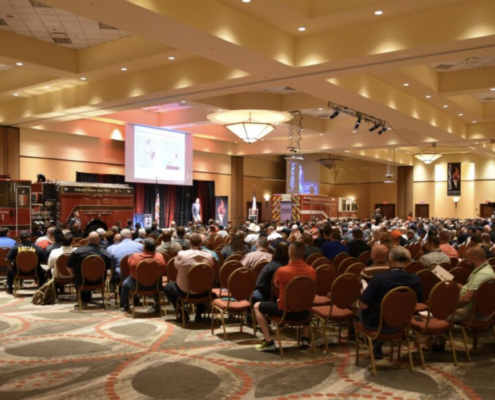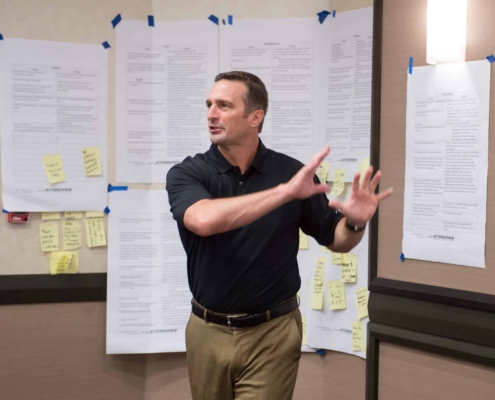 https://www.afterburner.com/wp-content/uploads/2024/09/leadership-symposium-afterburner.png
1050
1832
Nate Riggins
/wp-content/uploads/2024/07/Afterburner-Logo-Resize-Fullcolor-300x93.png
Nate Riggins2024-01-26 15:53:082024-11-20 14:55:53Decoding the 3 Crucial Leadership Situations
https://www.afterburner.com/wp-content/uploads/2024/09/leadership-symposium-afterburner.png
1050
1832
Nate Riggins
/wp-content/uploads/2024/07/Afterburner-Logo-Resize-Fullcolor-300x93.png
Nate Riggins2024-01-26 15:53:082024-11-20 14:55:53Decoding the 3 Crucial Leadership Situations
In the past few years, many have predicted that the pandemic would change the nature of work in concrete ways – that there would be distinct pre-pandemic and post-pandemic work cultures. Instead, we’ve seen the nature of work whipsaw back and forth between extremes: remote and in-office, eager hiring and sweeping layoffs.
Just like Fighter Pilots strive to stay focused amid chaotic and rapidly changing circumstances, companies today are contending with a business environment that rarely looks the same two months in a row. Building trust as a leader is hard enough already – if you’re a manager, director, vice president, or C-level executive, all of this change and uncertainty can make it even harder.
And if your team doesn’t trust your leadership, good luck inspiring them to perform at their best and hit your revenue goals.
Here are the top three ways the current business landscape makes it difficult to build trust as a leader, and what you can do to overcome these obstacles, build a cohesive and aligned team, and execute flawlessly.
1. Indecisive leadership is bad for trust-building efforts
Recent headlines have painted a picture of a business landscape characterized by flip-flopping. As leaders stutter-step their way out of the pandemic, they’ve often had trouble sticking with newly-implemented policies.
First, companies started bringing employees back into the office, only to send them remote again when a new variant caused a spike in COVID cases. In the spring of 2022, they posted so many job openings it was impossible to fill them all. That summer, they started laying people off as the pinch of inflation and rate increases took hold.
It would be a blunder to overlook the ways all of this makes it hard to build trust as a leader. After all, this kind of flip-flopping has a tangible impact on your employees. Ever-changing work-from-home policies are highly disruptive to their workflows, and new fears about job security significantly undermine morale. The more indecisive you are as a leader, the more your employees will see you as a source of turbulence instead of guidance.
2. Remote workflows are too easy to mismanage
Several years have now passed since the pandemic sent much of the workforce into full and indefinite work-from-home mode. Many teams are still working remotely full-time today.
If you haven’t been keeping tabs on the psychological impact this has had on your employees, you could be facing a trust shortfall. Working from home can be profoundly isolating over time. It can cause team members to feel divested from their Mission Objective, and undervalued by their leaders.
Recent headlines about the rise of productivity tracking for remote workers haven’t helped. Publicity over these tracking practices has created an atmosphere of suspicion that can be harmful to dynamics between teams and their leaders. Building trust as a leader will remain an uphill battle as long as leaders aren’t prepared to reciprocate that trust.
3. Building trust as a leader clashes with economic forces
As inflation persists and the future of the pandemic remains uncertain, companies are making macro-level changes with unusual frequency. Leaders come and go, strategies shift, and org charts are reorganized.
From the employee perspective, this can send the message that company leaders don’t know what they want, aren’t in control, and don’t have a solid understanding of the forces shaping the business world. We’ve discussed the importance of being able to make quick, smooth strategic pivots to navigate economic turbulence – equally important is the ability to make these pivots while continuing to demonstrate stability and control.
How leaders can persevere and build trust across their teams
Amid these challenging circumstances, building trust as a leader is dependent upon your ability to:
- Be as consistent as possible with your policies: Occasional pivots are unavoidable, especially in a rapidly-evolving business landscape. But you can still do your best to avoid knee-jerk policy changes based on new circumstances that may soon be outdated.
- Make trust a two-way street: Create a culture of accountability without making your employees feel that you don’t trust them.
- Close the distance between your remote employees and your team goals: Many employers conduct regular progress checks with their remote employees regarding immediate, short-term tasks. But too many have neglected to also provide transparent updates on company strategy and news, or to make sure their employees still understand the impact of the work they’re doing and are bought into the team’s mission.
Conclusion
Ultimately, building trust as a leader comes down to breaking down barriers between you and your team. Build transparency. Get on their level. Show that you’re invested not just in your company’s bottom line, but in their success.
A great place to start is at a high-energy seminar, workshop, or keynote, where you and your team can work together to build the collaboration and execution skills of elite military teams and apply them to your business goals. Get in touch with Afterburner to learn how to get started.
Share This Post
More Like This
 https://www.afterburner.com/wp-content/uploads/2024/09/leadership-symposium-afterburner.png
1050
1832
Nate Riggins
/wp-content/uploads/2024/07/Afterburner-Logo-Resize-Fullcolor-300x93.png
Nate Riggins2024-01-26 15:53:082024-11-20 14:55:53Decoding the 3 Crucial Leadership Situations
https://www.afterburner.com/wp-content/uploads/2024/09/leadership-symposium-afterburner.png
1050
1832
Nate Riggins
/wp-content/uploads/2024/07/Afterburner-Logo-Resize-Fullcolor-300x93.png
Nate Riggins2024-01-26 15:53:082024-11-20 14:55:53Decoding the 3 Crucial Leadership Situations https://www.afterburner.com/wp-content/uploads/2024/09/creating-a-strategy-1.jpeg
664
1000
Nate Riggins
/wp-content/uploads/2024/07/Afterburner-Logo-Resize-Fullcolor-300x93.png
Nate Riggins2024-01-03 08:00:192024-11-20 14:55:544 Questions You Have to Ask When Creating a Strategy
https://www.afterburner.com/wp-content/uploads/2024/09/creating-a-strategy-1.jpeg
664
1000
Nate Riggins
/wp-content/uploads/2024/07/Afterburner-Logo-Resize-Fullcolor-300x93.png
Nate Riggins2024-01-03 08:00:192024-11-20 14:55:544 Questions You Have to Ask When Creating a Strategy https://www.afterburner.com/wp-content/uploads/2024/09/CVMV_0008.jpg
1547
2100
Nate Riggins
/wp-content/uploads/2024/07/Afterburner-Logo-Resize-Fullcolor-300x93.png
Nate Riggins2022-11-10 15:37:382024-11-20 14:55:585 Leadership Skills to Get Your Revenue Engine Roaring in Q4
https://www.afterburner.com/wp-content/uploads/2024/09/CVMV_0008.jpg
1547
2100
Nate Riggins
/wp-content/uploads/2024/07/Afterburner-Logo-Resize-Fullcolor-300x93.png
Nate Riggins2022-11-10 15:37:382024-11-20 14:55:585 Leadership Skills to Get Your Revenue Engine Roaring in Q4
A Word from Murph: Right Now, Leadership in Business Means Going Back to Basics
Inspiration, Leadership, Leadership Development https://www.afterburner.com/wp-content/uploads/2024/09/AdobeStock_198086711-1.jpeg
1265
2048
Nate Riggins
/wp-content/uploads/2024/07/Afterburner-Logo-Resize-Fullcolor-300x93.png
Nate Riggins2020-03-30 09:00:352024-11-20 14:56:037 Leadership Tips to Motivate Your Remote Employees
https://www.afterburner.com/wp-content/uploads/2024/09/AdobeStock_198086711-1.jpeg
1265
2048
Nate Riggins
/wp-content/uploads/2024/07/Afterburner-Logo-Resize-Fullcolor-300x93.png
Nate Riggins2020-03-30 09:00:352024-11-20 14:56:037 Leadership Tips to Motivate Your Remote Employees https://www.afterburner.com/wp-content/uploads/2024/09/woman-showing-how-to-improve-your-situational-awareness-with-map-in-background-1.png
667
1000
Nate Riggins
/wp-content/uploads/2024/07/Afterburner-Logo-Resize-Fullcolor-300x93.png
Nate Riggins2020-03-22 07:00:122024-11-20 14:56:033 Ways to Improve Your Situational Awareness
https://www.afterburner.com/wp-content/uploads/2024/09/woman-showing-how-to-improve-your-situational-awareness-with-map-in-background-1.png
667
1000
Nate Riggins
/wp-content/uploads/2024/07/Afterburner-Logo-Resize-Fullcolor-300x93.png
Nate Riggins2020-03-22 07:00:122024-11-20 14:56:033 Ways to Improve Your Situational Awareness https://www.afterburner.com/wp-content/uploads/2024/09/team-sitting-in-a-meeting-listening-to-how-to-cope-with-task-saturation-1.png
439
1000
Nate Riggins
/wp-content/uploads/2024/07/Afterburner-Logo-Resize-Fullcolor-300x93.png
Nate Riggins2020-02-14 09:00:522024-11-20 14:56:04Identifying your Task Saturation Coping Mechanisms
https://www.afterburner.com/wp-content/uploads/2024/09/team-sitting-in-a-meeting-listening-to-how-to-cope-with-task-saturation-1.png
439
1000
Nate Riggins
/wp-content/uploads/2024/07/Afterburner-Logo-Resize-Fullcolor-300x93.png
Nate Riggins2020-02-14 09:00:522024-11-20 14:56:04Identifying your Task Saturation Coping Mechanisms https://www.afterburner.com/wp-content/uploads/2024/09/Men-writing-in-notebooks-to-help-eliminate-task-saturation-1.png
511
1000
Nate Riggins
/wp-content/uploads/2024/07/Afterburner-Logo-Resize-Fullcolor-300x93.png
Nate Riggins2020-02-05 09:00:582024-11-20 14:56:043 Simple Ways to Eliminate Task Saturation
https://www.afterburner.com/wp-content/uploads/2024/09/Men-writing-in-notebooks-to-help-eliminate-task-saturation-1.png
511
1000
Nate Riggins
/wp-content/uploads/2024/07/Afterburner-Logo-Resize-Fullcolor-300x93.png
Nate Riggins2020-02-05 09:00:582024-11-20 14:56:043 Simple Ways to Eliminate Task Saturation https://www.afterburner.com/wp-content/uploads/2024/09/two-women-looking-at-paper-forcing-communication-in-business-1.png
667
1000
Nate Riggins
/wp-content/uploads/2024/07/Afterburner-Logo-Resize-Fullcolor-300x93.png
Nate Riggins2019-06-19 09:00:192024-11-20 14:56:06Why is Tone so Important When it Comes to Communication in Business?
https://www.afterburner.com/wp-content/uploads/2024/09/two-women-looking-at-paper-forcing-communication-in-business-1.png
667
1000
Nate Riggins
/wp-content/uploads/2024/07/Afterburner-Logo-Resize-Fullcolor-300x93.png
Nate Riggins2019-06-19 09:00:192024-11-20 14:56:06Why is Tone so Important When it Comes to Communication in Business?About Us
Building Strong Teams Through the Guidance of Fighter Pilot Keynote Speakers.

